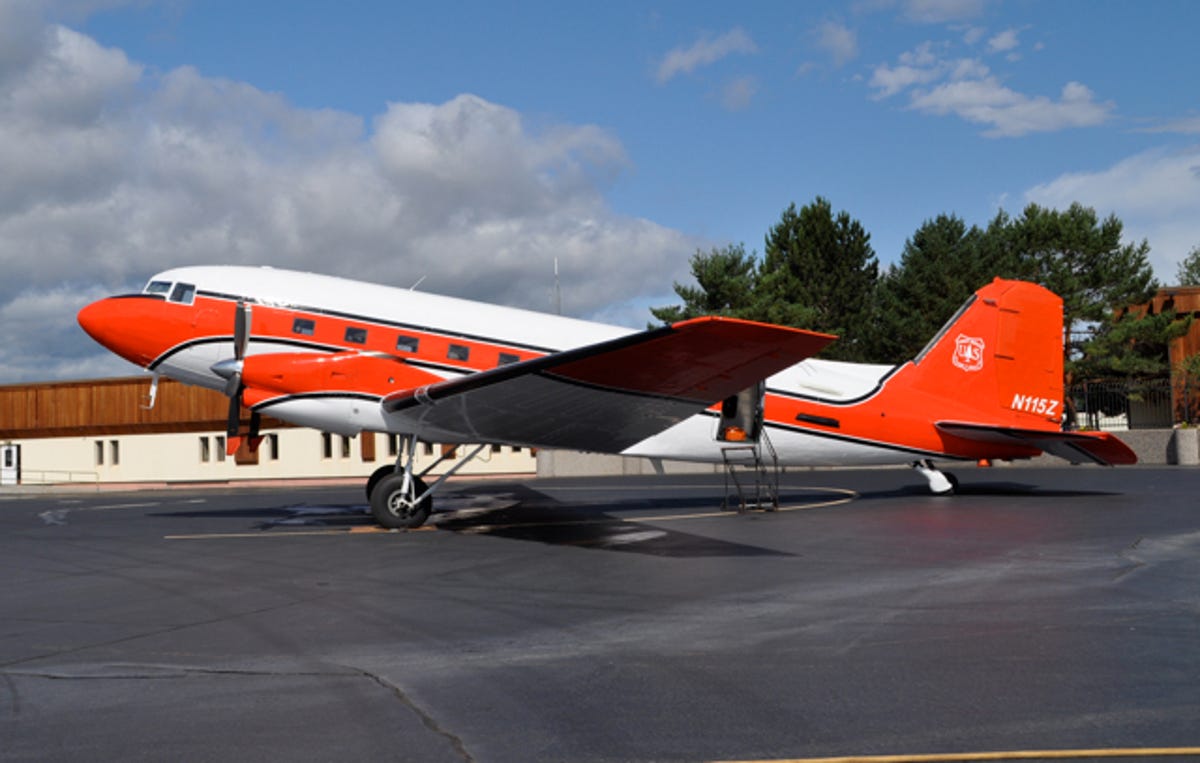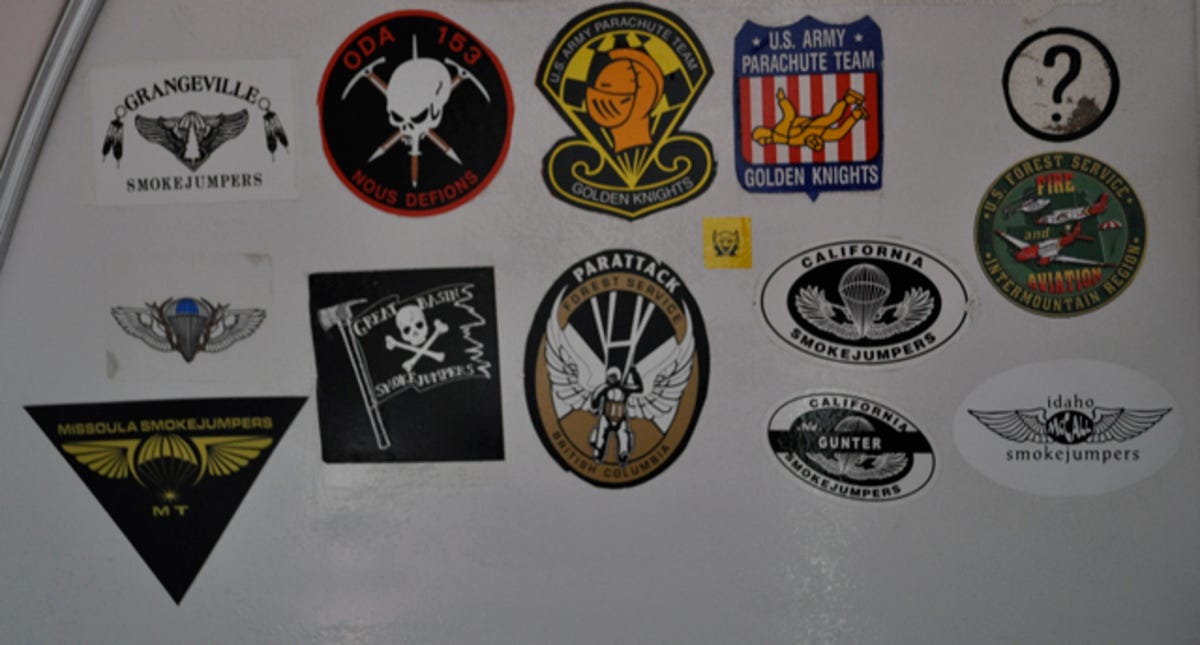Photos: Smokejumpers preparing for fire battles
In Missoula, Mont., a group of about 60 men and women are Forest Service hired guns, trained to jump out of airplanes and attack wildfires in the most remote terrain. CNET News reporter Daniel Terdiman visited with them on Road Trip 2009.<br>

Gorgeous DC-3
All around the United States, there are large, difficult-to-reach regions of terrain that, in the case of an outbreak of fire, are often beyond the quick reach of ground-based firefighters.
When fire does break out in terrain like that--and is deemed worth fighting--the U.S. Forest Service may well send in teams of what are called Smokejumpers, groups of highly trained men and women who, when duty calls, load themselves into special airplanes and then jump in to fight the remote fires.
On his Road Trip 2009 project, CNET News reporter Daniel Terdiman visited with the Smokejumpers in Missoula, Montana, and got a chance to see, first hand, their planes, their equipment and their daily preparations.
This is a 1944 Douglas DC-3, one of the most iconic planes of all time. It is used by the U.S. Forest Service as a Smokejumper plane, and can hold a 20-person crew.
Click here for the entire Road Trip 2009 package.
Inside the DC-3
A look inside the 1944-era Douglas DC-3 that is used by the U.S. Forest Service as a Smokejumper plane. The plane is kept loaded with equipment and packed parachutes in case it is needed at a moment's notice.
The plane was retrofitted in 1990 and was very recently painted, making it look beautiful and new.
Click here for the entire Road Trip 2009 package.
DC-3 cockpit
The cockpit of the DC-3 used by the U.S. Forest Service as a Smokejumper plane based out of Missoula, Montana.
Click here for the entire Road Trip 2009 package.
Shorts Brothers C-23 Sherpa
This is a Shorts Brothers C-23 Sherpa, another Smokejumpers plane used by the U.S. Forest Service in Missoula, Mont.
The plane can carry a 14-person crew, 10 of whom are two-person Smokejumper teams, two of whom are pilots and two of whom are spotters.
Click here for the entire Road Trip 2009 package.
Packed and ready to go
A look at the packed inside of the C-23 Sherpa. The plane, like the DC-3, is kept loaded and packed so that if Smokejumpers are needed, the plane can be in the air in minutes to fight a fire.
Click here for the entire Road Trip 2009 package.
Sherpa cockpit
The cockpit of the C-23 Sherpa used as a Missoula, Mont.-based Smokejumpers plane.
Click here for the entire Road Trip 2009 package.
Static line
On-board the Sherpa, Smokejumpers who use traditional round parachutes will clip onto this static line so that when they jump, the parachute automatically deploys. The idea is to do the operation as they jump, giving them enough time to pull their backup parachute if the main one doesn't open properly.
These days, many Smokejumpers are using more modern-style square parachutes, and those who use them jump out of the plane without clipping on to the static line, because they will free fall awhile before opening their parachutes.
Click here for the entire Road Trip 2009 package.

Smokejumper decals
On-board the C-23 Sherpa, a batch of decals signify the different groups of Smokejumpers who have ridden the plane en route to remote fires.
Click here for the entire Road Trip 2009 package.
Passenger fashion guidelines
A sheet of paper posted on board the Sherpa explains the "fashion guidelines" on the plane. The idea is that once in the air, Smokejumpers need to be set to jump at a moment's notice. As well, they need to have control of their gear.
Click here for the entire Road Trip 2009 package.
Packed cargo parachutes
Inside the Smokejumpers center in Missoula, Mont., a shelf sits stuffed with packed cargo parachutes.
Click here for the entire Road Trip 2009 package.
Hanging parachutes
In a special room where the Smokejumpers' parachutes are repaired, several of the 'chutes hang from the ceiling, where they can be inspected to make sure they're in proper shape before being re-packed.
Click here for the entire Road Trip 2009 package.
Parachute diagram
A cheat sheet explains all the various elements of a Smokejumpers parachute, so that when someone is inspecting them, they know exactly what to look for.
Click here for the entire Road Trip 2009 package.
Memory of Don Mackey
On a wall in the Missoula, Mont., Smokejumpers center is a memorial plaque for Don Mackey, a Smokejumper who was killed fighting a fire in 1994.
Click here for the entire Road Trip 2009 package.
Click here for the entire Road Trip 2009 package.
Briefing graphic
To start their day, the Smokejumpers are given a daily briefing in which they are told about current weather conditions around the West. The idea is to help them prepare and get a sense of where they should expect fires to break out. The drier the region, and the more thunderstorms there are, the higher the likelihood of a fire breaking out in a remote region of terrain.
This is one graphic they were shown on the day that CNET News reporter Daniel Terdiman visited. It showed hot spots and wind patterns.
The day Terdiman visited was wet, as had been many of the previous days. But the Smokejumpers were told to expect drier weather and prime fire conditions within a few days.
Click here for the entire Road Trip 2009 package.
Inside the pack
On a wall at the Smokejumpers center, this display showcases the contents of one of the bags the men and women carry with them when they jump. It contains all kinds of first-aid gear.
Click here for the entire Road Trip 2009 package.
Retardant
On the tarmac near the Smokejumpers center are these large tanks, which are used to mix and store fire retardant. That is then loaded aboard tankers, which will fly out and dump the liquid over fires.
Click here for the entire Road Trip 2009 package.
Flames rising
Near the Smokejumpers center is a separate U.S. Forest Service facility, the Fire Lab. There, groups of government scientists research everything about fire: how it spreads, predicting modeling about how fires grow and how fuel--wood, undergrowth, etc.--ignites, among other things.
This is an experiment in the Fire Lab designed to study how fuel ignites. The idea is to demonstrate that radiant heat is not enough to catch something on fire, but that actual flames are needed. And here, this device is meant to show the dynamics of flames so that the researchers can study how flames work.
Click here for the entire Road Trip 2009 package.
LIDAR
The U.S. Forest Service Fire Lab has begun using a device called LIDAR, which sends a very strong laser beam into the atmosphere, where it hits high-altitude particles of smoke and is reflected back to the device.
By measuring the image that comes back, researchers can study the dynamics of smoke plumes and better understand how high they are, how they're changing over time and more.
Click here for the entire Road Trip 2009 package.
LIDAR truck
The LIDAR truck, which can be driven out to where fires are in progress, or are expected, and which can be ready to start working in 40 minutes.
Click here for the entire Road Trip 2009 package.
Fuel best test platform poster
Inside the Fire Lab, a poster on the wall demonstrates how researchers there can examine how a bed of fuel--shredded wood--ignites and burns on an ascending angle.
Click here for the entire Road Trip 2009 package.